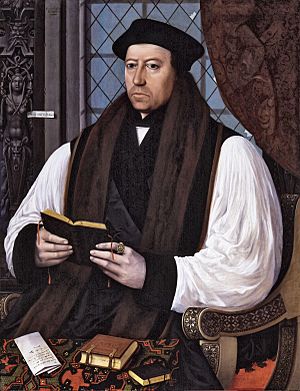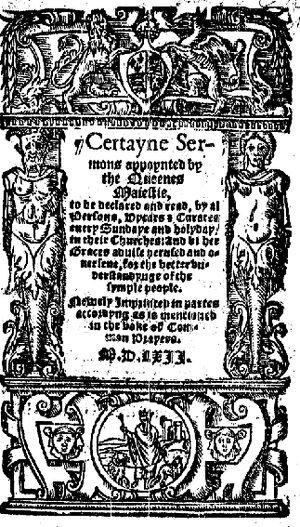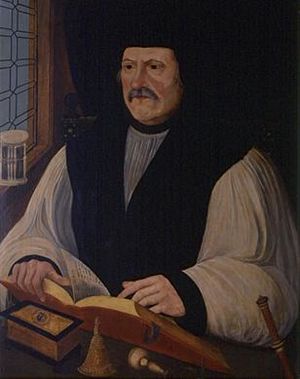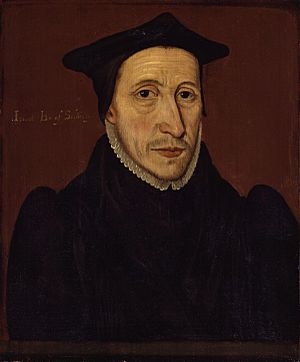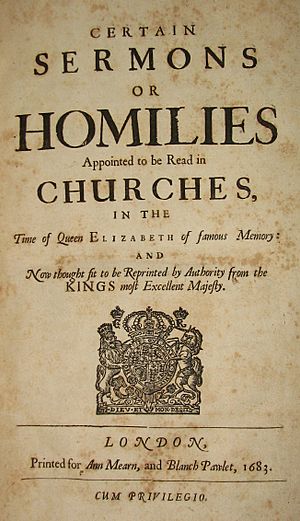The Books of Homilies facts for kids
The Books of Homilies (published in 1547, 1562, and 1571) are two important collections of thirty-three sermons. These sermons were created to explain the official beliefs of the Church of England in great detail. They were meant to be read in churches, as stated in the 35th Article of the Thirty-Nine Articles of Religion. The full name of this collection is Certain Sermons or Homilies Appointed to Be Read in Churches. They are a key part of the Church of England's basic rules and teachings.
Contents
How the Church of England Changed
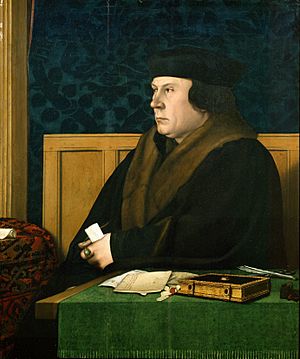
In the 1530s, the Church of England separated from the Church of Rome. This happened when King Henry VIII of England became the main leader of both the government and the church in England. Because of this big change, it was important to teach the new ideas of the English Reformation to everyone. This included new Christian beliefs, ways of thinking about God, and how people should practice their faith. These teachings needed to reach all church groups, called congregations, across the country.
Before this, church services were entirely in Latin, and Holy Communion was only given twice a year. However, new religious ideas had been quietly growing among people for a long time. This was partly due to the Wycliffite tradition and new learning from universities across Europe.
Early Attempts to Define Beliefs
Archbishop Thomas Cranmer and Thomas Cromwell (who was a powerful advisor to the King) led efforts to create new church teachings. They started with the Ten Articles in 1536, which had some ideas similar to the Lutheran church.
In 1537, they added a book called the Bishops' Book, also known as The Institution of a Christen Man. This book was divided into four main parts:
- Explaining the Apostles' Creed (a statement of Christian belief)
- Describing the Seven Sacraments (holy rituals)
- Explaining the Ten Commandments (God's rules)
- Explaining the Pater noster (the Lord's Prayer) and the Ave (Hail Mary), along with ideas about Justification (being made right with God) and Purgatory.
The bishops dedicated this book to King Henry. It was first ordered to be read in churches but was later stopped so it could be changed. In 1539, the Six Articles became law. These were strict rules that went against some of the newer ideas, and breaking them led to severe punishments.
The revised book, called the King's Book, was published in 1543. Its full title was The Necessary Doctrine and Erudition for Any Christen Man. This book was discussed and approved in 1540, around the time Cromwell lost power. The King's Book had similar sections to the Bishops' Book. It gave long explanations for each part, line by line.
Edward VI's Changes: The First Book of Homilies (1547)
Under Archbishop Thomas Cranmer, who served King Henry and then King Edward VI (who ruled from 1547 to 1553), the first collection of Homilies was created. This first book, published in 1547, was called Certayne Sermons, or Homelies appoynted by the kynges Maiestie. In the same year, the strict Six Articles were cancelled.
There was a strong need for a clear and official statement of beliefs that everyone could understand. This book was given to priests to read to their congregations. The introduction to the first edition, written under King Edward's authority, explained why it was needed. It said that the "ungodly doctrine" of the "Bishoppe of Rome" had led people away from God's commands. The King ordered that priests should read these homilies every Sunday (unless a different sermon was given) until the whole book was finished, and then start again.
This first volume of Homilies came out before the new church services were published in the Edwardian Book of Common Prayer of 1549. It also came before its revised version of 1552 and the Forty-two Articles in 1553. Volume I has twelve sermons, mostly written by Cranmer. They focus on the nature of God and the idea of Justification by Faith (being made right with God through faith). The King's official printers, Richard Grafton and Edward Whitchurch, printed them.
Elizabeth I's Changes: The Second Book of Homilies (1563, completed 1571)
The First Book of Homilies was re-published in 1562. Its sermons were divided into parts to make them easier to understand. The Queen's order for them to be read was included in the introduction. This new edition, and others from 1563, 1567, and 1571 (when the Second Book of Homilies was added), happened during the time of Matthew Parker as archbishop. This was from the start of Queen Elizabeth I's rule until his death in 1575.
These publications followed a difficult period when Queen Mary I (who ruled from 1553 to 1558) brought the English Church back under Rome's control. During her reign, Archbishop Reginald Pole was in charge, and Thomas Cranmer was executed as a heretic in 1556. The Forty-two Articles were not used during Mary's reign. However, they became important again with Elizabeth's new religious rules, known as the Elizabethan Religious Settlement.
The 1563 Edition
The Second Book of Homilies was mainly written by Matthew Parker, with help from Bishop John Jewel and others. It was printed by Richarde Iugge and John Cawood, who were "printers to the Queenes Maiestie." Parker said that the Homilies had already been printed in 1562 and were just waiting for the Queen's final approval in mid-1563. This book was called Certayne Sermons appoynted by the Queenes Maiestie and contained twenty sermons. More copies were printed in the following years. This publication came after the church council approved the Thirty-Nine Articles. The Queen removed one article from these to help calm down her Catholic subjects. These books completed the full set of Homilies that had been planned in the First Book.
The 1571 Edition
The complete second series of twenty-one homilies, called The Second Tome of Homilees, was published in 1571. This happened after Queen Elizabeth was excommunicated (kicked out of the Catholic Church) by the Pope's official order, Regnans in Excelsis. The Thirty-fifth Article (which is still in use today) states:
"The second Book of Homilies... contains good and healthy teaching, and is necessary for these times, just like the first Book of Homilies... Therefore we believe they should be read in Churches by the Ministers, carefully and clearly, so that the People may understand them."
What the Homilies Are Like
Many of the sermons are simple encouragements to read the holy scripture daily and live a life of prayer and faith in Jesus Christ. Other parts are long, scholarly writings meant to teach church leaders about theology, church history, and the Roman Catholic Church's teachings that the Reformed Anglican faith had moved away from. Each homily has many notes that refer to the Bible, the Church Fathers (early Christian writers), and other original sources.
The longest homily is the second one in the second book, titled "Against Peril of Idolatry." It is about 136 printed pages long in the 1571 edition and is divided into three parts. The first part explains the rules from the Bible against worshipping images. The second part discusses what early Christian writers said about this topic. It also traces the Iconoclastic Controversy, which caused a split between Western and Eastern churches. The third part describes how some Roman Catholic religious teachings and practices were seen as leading to idol worship from the perspective of the Reformed Church. For example, it mentions:
"And where one saint hath images in divers places, the same saint hath divers names thereof, moste lyke to the Gentiles. When you heare of our Lady of Walsingham, our Lady of Ipswich, our Lady of Wilsdon, and suche other: what is it but an imitation of the Gentiles idolaters? Diana Agrotera, Diana Coriphea, Diana Ephesia, etc., Venus Cipria, Venus Paphia, Venus Gnidia. Whereby is evidently meant, that the saint for the image sake, shoulde in those places, yea in the images them selves, have a dwellyng, whiche is the grounde of theyr idolatrie. For where no images be, they have no such meanes" (at p. 99).
The homilies use many old spellings of Biblical names, like Noe for Noah and Esay for Isaiah. The phrase "mummishe massyng" appears in the fifteenth sermon of the second book. This phrase describes people who come to the Lord's Supper "unreverentlye" (without respect), not understanding its meaning, as if it were just a silent play.
Later Editions
Many different versions of the Homilies were printed over the years. Some important later editions include:
- John Norton, for Joyce Norton and Richard Whitaker (London, 1633/1635)
- Ralph Hodkinson and John Norton for Richard Whitaker (London 1640 [1650])
- Thomas Roycroft, for Andrew Crooke, Samuel Mearne and Robert Powlet (London 1673)
- Ann Mearn and Blanch Pawlet (London 1683)
Today, the most common edition of the Homilies was put together in 1859 by John Griffiths and first published by Oxford University Press. A newer, carefully reviewed edition was published in 2015, edited by Gerald Bray. In 2021, an edition of the First Book of Homilies was published in modern English for the Church Society, edited by Lee Gatiss.
See also
- Anglican doctrine
- Tract 90
- Postil


